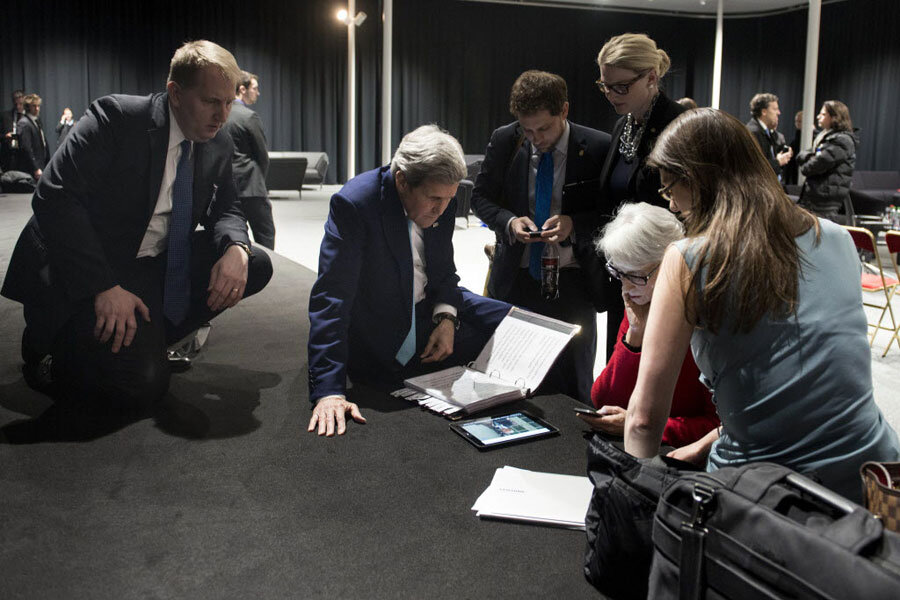How Iran deal could help head off a future nuclear crisis
Loading...
| WASHINGTON
The Iran nuclear deal reached Thursday may only be an outline, with much of the most difficult work still to come before a June 30 deadline. But already some experts are seeing in the deal a potential template for how to block the emergence of a new generation of nuclear-armed powers.
Galloping electricity needs and intensifying international efforts to cut carbon emissions are prompting more countries to add nuclear power plants. That makes the need for toughened international restrictions on supposedly “peaceful” civilian nuclear programs urgent, some say.
In the case of Iran, the international community moved aggressively to prevent a civilian program from becoming something more dangerous. But the situation has shown how other countries could take the same path if not suitably monitored.
As early as this month, world powers could begin to consider whether the Iran deal, which is shaping up to be the most stringent international plan ever for limiting a civilian nuclear program, should become part of a new global standard.
The Iran framework agreement’s provisions “seem to reflect a growing appreciation by officials of just how potentially useful ‘peaceful’ nuclear activities and materials can be for making bombs,” says Henry Sokolski, executive director of the Nonproliferation Policy Education Center in Washington. “Why wouldn’t we want to make these rules apply generally and become an international standard?”
Negotiators must still lay down specifics and clarify ambiguous language, but the Iran framework agreement sets strict limits on uranium enrichment, bans plutonium reprocessing, and establishes an intrusive international inspections regime.
An opportunity to gauge interest in extending some of these restrictions globally will come later this month at the month-long review conference of the Treaty on the Non-Proliferation of Nuclear Weapons, or NPT.
The conference could be the right moment, some diplomats say, for world leaders to test the global appetite for making some of the Iran deal’s tough provisions a model for international restraints. If nothing else, some say, world leaders need to consider how the Iran crisis underscores weaknesses in the nonproliferation regime. Iran, after all, was a signatory of the NPT.
“The Iranian problem has exposed significant vulnerabilities under the Nuclear Nonproliferation Treaty, especially the absence of a clear divide between civilian and nuclear programs,” wrote William Burns, a former deputy secretary of State and now president of the Carnegie Endowment for International Peace, in a New York Times opinion piece Friday.
As more countries look to nuclear technologies to meet energy needs, the international community will need to build a “sturdy firewall” between peaceful and military nuclear uses, said Mr. Burns. Measures of the Iran agreement could be seen as “useful future benchmarks.”
But others note that, during this month's NPT conference, the United States and five other world powers will still be hammering out the details of the deal with the Iranians. As a result, it is unlikely that the deal would become the showcase of the meeting, which is a once-every-five-years event put on by the United Nations.
Others also argue that Iran is a special case, given that it has proven to be “particularly untrustworthy” regarding its nuclear program, Mr. Sokolski notes. But he doesn't see that as an argument against expanding the principles in the Iran deal.
“What makes us so sure we can trust everybody else, especially when we’re talking about materials that are so dangerous?” he adds. “I think we can’t.”
President Obama has made nuclear security and nonproliferation a cornerstone of his presidency. One of his first major international initiatives after taking office was to convene a nuclear security summit in 2010 in Washington. The aim was to improve the safeguarding of weapons-grade uranium and plutonium stockpiles.
Since then, the summits have become a recurring international event. Next year, Mr. Obama will again host the summit, this time in Chicago. Some experts expect the issue of weapons-grade plutonium to become a central focus of the summit, especially since Japan is planning to reopen its plutonium reprocessing plant at Rokkasho about the same time as the summit.
South Korea and China are thought to be watching Japan as they consider getting into reprocessing themselves – leading some experts to warn of a coming Asian plutonium crisis.
“A number of people are concerned we aren’t paying enough attention to the proliferation of weapons-useful plutonium,” Sokolski says. “I think if you have a ban on Iranian reprocessing, it at least raises the question of why other countries shouldn’t be subject to that, too.”
The Iranian deal may not lead to a quick toughening of global nonproliferation measures, but at the very least it is prompting a conversation, Sokolski says.
“This deal definitely raises the question: How much civilian nuclear activity is safe? And it does it in a way that has not been raised before,” he says. “The global application of some of these measures may not be put on the map immediately,” he adds, “but in the long run it will have to.”






